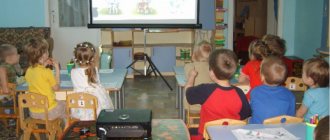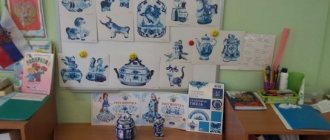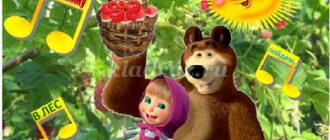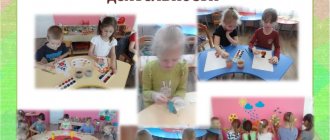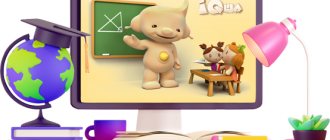Project “Spring is Red!” in preparatory group 5 “WAVE”
Transcript
1 Municipal autonomous preschool educational institution d/s 47 Municipal District of Novorossiysk Project “Spring is Red!” in preparatory group 5 “WAVE” Educator: Ferderer Ekaterina Viktorovna 2022 Novorossiysk
2 “Spring” Project: medium-short term. Type: educational, playful, creative. Project implementation period: 3 weeks (from 10.04 to 2016). Project participants: children of the preparatory group (6-7 years old, teachers, parents.) Goal: to familiarize children with nature in all its manifestations in the spring, as well as to promote children’s creative expression of their impressions in productive activities. Objectives of the project activity: - expand the understanding of seasonal changes in nature; — deepen children’s knowledge about the life of birds and animals in the spring; - develop artistic taste, aesthetic sensitivity and creativity of children; — to cultivate a desire to learn more about the peculiarities of the nature of their region. Relevance: A child’s knowledge of the world around him, including knowledge of nature. The child must feel responsible for all the living nature that surrounds him. Therefore, it is necessary to teach to take care, to love nature from an early age and to take care of it. In older preschool age, children love to observe changes in nature. Through active productive activities, namely observation, drawing, sculpting, applications, stories, retellings, reading fiction, the project helps to more clearly study the main signs of spring. Project outcome: The project will help children master and comprehend the knowledge they have acquired, broaden their horizons and ideas about the world around them.
3 Understand that we must love and protect nature, and not destroy it. Children will begin to share the information they receive with other children. Forms of project implementation: Visual: observations, encyclopedias, photographs, paintings, books. Verbal: Conversations, reading fiction Research: searching for materials, productive activities Information support. — Video presentation - Encyclopedias, books, illustrations of paintings Logistics. -Camera; -Record player; -Computer. Project development stages: First stage. Preparatory: Children are invited to discuss the questions: How is spring different from other seasons? What changes occur in plants and animal life? Second phase. Project development. 1. Make participants aware of the importance of this topic. 2. Selection of methodological literature. 3. Selection of visual and didactic material, fiction (on the topic of the project). Third stage. Project implementation. Direct educational activities. Conducting classes in cognitive and artistic-aesthetic cycles;
4 Learning poems (Competition for experts on poems and songs about spring); Joint participation of children, teachers and parents in the competition and exhibition. Fourth stage. Project results. Work with parents: Joint walks in nature, article in the parent corner “Talking with children about nature”, landscaping the area Practical part Direct educational activities (knowledge of the Federal Center for Contemporary Culture) Conversations: - “Spring is red!” - “Who enjoys spring more?” — “Primroses” — “What do spring birds sing about?” Creative activities: - Paper construction: “Starlings”, “Butterflies”, “Boats” - Modeling: “Birds”, “Insects” - Drawing: “Starlings have arrived”, “Spring forest”, “Insects”, “Primroses” Applique : “Mimosa Branch”, “Bouquet of Flowers” - Interaction with parents: collecting illustrations, pictures, inventing, composing riddles about spring for the “Spring” album. Creation of the exhibition: “Birdhouses and bird feeders”, creation of a small book “Migratory birds in spring” - Reading fiction: studying encyclopedias, reading the works of A. Pleshcheev “Already the snow is melting”, A. Pushkin “Nature with a clear smile”, B. Zakhoder “Spring walked for a long time”, V. Bianchi “Sinichkin’s calendar”, Y. Akim “The first butterfly sat on a bench”, Sokolov “Seasons”, Nekrasov “Grandfather Mazai and the hares”. Communication development:
5 - Examination of paintings about nature by Surikov “The Rooks have Arrived”, Ostroukhov “Early Spring”, Levitan “Spring”, “March” Musical activity: Listening to P.I. Tchaikovsky album “Seasons”: “April”, “Snowdrop”, A Vivaldi "Spring"; Learning songs about spring Games for free activity: Didactic games: - “Choose a word” - “Who lives where?” - “Name the plants” - “Guess the animal” - “Whose leaf?” - “Where does it grow?” Plot role-playing game: - “At the dacha” Director’s game “Depict an animal, and you guess” Research activities: - planting onions “Vegetable garden on the window”; - sowing flower seeds for seedlings; - observation of tree branches; - experiments with water, testing of boats, children's creativity activity "Spring is coming - make way for spring." Detailed plan for one week of the project Day 1 (DATE). Objectives Expand your understanding of the characteristic signs of spring; about the arrival of birds; about the connection between the phenomena of living and inanimate nature and seasonal types of labor.
6 Learn to harmoniously arrange the plot on the entire sheet of paper, develop a sense of composition “Riddles about nature.” D.I. “The fourth odd one” "Who lives where?" P.I. “Transformations” Drawing “Early Spring. Snowdrop" Role-playing game "Spring Journey to the Forest." Listening to audio recordings of “bird voices”. Reading E. Shim “Sun Drop”. Situational conversation based on photo illustrations on the topic “Early Spring” Artistic word by A. Pleshcheev “The snow is already melting” Name the months of spring, winter, summer, autumn in order; naming the days of the week through the game “What comes first, what comes next.” Activation of the dictionary: thaw, drops, melted snow, etc. through the game “Who is bigger?” Issue of recommendations for parents during spring walks with children.
7 2nd day. Objectives Expand your understanding of the arrival of birds. Develop curiosity and interest in nature. Develop environmentally friendly behavior in children. Drawing “Shade in the silhouettes of birds.” Game “Recognize the bird by description?” Reading N. Sladkov “Spring Joys”. Role-playing game “Walk through the spring forest.” Competition for experts on poems and songs about spring. Bird watching while walking. Introduce the sign: The early arrival of rooks and larks means a warm spring. A selection of works of art on the theme “Poets and writers about spring.” 3rd day. Objectives Develop the ability to write short stories about changes in the forest in spring. Learn techniques for creating three-dimensional appliqué. Foster a caring attitude towards nature.
8 Expand knowledge about nature conservation. Role-playing game “Spring in the Forest.” Paintings by I. Levitan “March” and I. Grabar “February Azure”. Application + paper design “Spring stream. Ship" Reading G. Skrebitsky "In a forest clearing. Spring" P\ and with elements of imitation birds. "Hares and the wolf." Conversation on the paintings by I. Levitan “March” and I. Grabar “February Azure”. Application + paper design “Spring stream. Ship." Observation of melt water in the spring (the formation of streams - where do they come from) Joint production of paper and wooden boats. 4th day. Objectives Develop ideas about plant changes in spring. Development of logical thinking. Develop environmentally friendly behavior in children. Develop a desire to engage in work. D. and “Gardeners”. D.I. “Yes-no.” Origami "Blooming tulips". Reading “Blue Frogs” by V. Bianchi. P\I “Go ahead, don’t fall near the fall.” Experimenting with water.
9 Role-playing game “building an ecological city.” Observation of plant growth in a natural area (what conditions are necessary for growth) Experimental lesson “Change of seasons.” Cleaning up the area and veranda. Involvement in the campaign “Our site is the most beautiful of all.” 5th day. Objectives: Repeat spring changes in living and inanimate nature. Formation of rules of behavior culture. Development of fine motor skills. D. and “12 months”, “Encrypted word”. "Spring changes in living and inanimate nature." Working with the calendar. D. and “Rules for washing.” Reading N. Pavlov “Under the Bush”. Game "Body". Situational conversation about spring changes in living and inanimate nature. Working with a calendar (learning to do weather analysis).
10 Situational conversation about dirty people and neat people. Creation of an exhibition of creativity “Spring is Red” Conclusions and results Thanks to this project, the work turned out to be productive and educational. The project helped children master and comprehend the knowledge they had acquired, broaden their horizons and ideas about the world around them. We understood that we need to love and protect nature, and not destroy it. Children shared the information they received and various sources with other children. Parents became interested in the results and products of the project.
11 MODELING “PET” EXPERIMENTING WITH WATER
12 DRAWING
13
14 OUTDOOR GAMES
Project for children of the senior group of kindergarten on the theme: Spring
Project for older preschoolers: Spring through the eyes of children
This material was developed for senior pupils and may be of interest to preschool teachers and primary school teachers.
Project manager : Stan Natalya Lvovna. Project participants : group teachers, music director, students, parents of students.
Situation analysis: Environmental education of children is one of the main tasks of a preschool institution. The subject environment of a preschool child includes various natural objects, so his familiarization with plants, animals, and inanimate natural phenomena is inevitable - this is a natural process of learning about the world around him and acquiring social experience. Therefore, the main content of environmental education is the formation in a child of a consciously correct attitude towards natural phenomena and objects that surround him and with which he becomes acquainted in preschool childhood. Preschool childhood is the initial stage of the formation of a person’s personality, his value orientation in the world around him. During this period, a positive attitude towards nature, towards the “man-made world”, towards oneself and towards the people around them is formed. And preschool age is the most sensitive period for the development of cognitive activity. Spring is the brightest and most dynamic season, which is why we chose this time of year when observations should be given great attention. Preschool children are not capable of long-term observations, however, during the spring, as seasonal phenomena increase, the teacher draws the children's attention to bright changes in inanimate nature, in the life of plants and animals. Let a child of five years old not yet be able to fully experience the charm of the beauty of nature unfolding before him, let the whimsical play of light and shadow in the forest, the grandeur of the bottomless sky dotted with twinkling stars, the delicate, rapidly changing shades of the sky illuminated by the last elude him. rays of sunset. Let him sometimes be attracted by all sorts of little things - life spilled everywhere, all this aroma of beauty is inhaled by the child and leaves a trace in him, which, if not now, then in the future will serve as material for deep, pure experiences. Thus, along with the memory of the feeling of the beauty of native nature and intimate intimacy with it, from the very early stages of life, a never-fading feeling of love for native places is brought up, which with age strengthens, expands and turns into one of the most durable and sublime human feelings - in love to motherland". Problem : According to the requirements of the Federal State Educational Standard, preschool children must be able to notice and formulate in speech changes in living and non-living nature in the spring, but children do not know how to do this. Reasons : - The Rainbow program offers a very small amount of ideas about the characteristics of natural objects and phenomena while establishing the simplest connections between them. — The group has not created conditions for children to become familiar with the season of spring. “Parents especially don’t pay attention to this topic at home. Project goal: Formation of skills to notice and formulate in speech changes in living and non-living nature, through a set of basic types of children's activities of senior preschool age. Objectives: for children
: Educational: 1. To form knowledge about seasonal changes in living and non-living nature with the arrival of spring.
2. To develop the ability to compare objects of living and non-living nature according to their main characteristics. 3. Form your own cognitive experience through observations of living and non-living objects. Developmental: 1. To develop children's observation skills in the process of familiarizing them with natural phenomena in the spring through identifying the signs of objects. 2. Develop logical thinking in children through comparison and generalization of objects in the surrounding world. 3. To develop children’s coherent speech when making personal judgments about nature and composing descriptive stories about changes in living and non-living nature in the spring. Educational: 1. Cultivate interest in seasonal changes in nature. for parents
: 1. Introduce the goals and objectives of the “Spring through the eyes of children” project.
2. Develop instructions for parents on the topic “Development of children’s cognitive abilities when observing nature in spring.” 3.Unleash the creative potential of parents by inviting them to participate in the exhibition “Spring has come!” 4.Consult parents on the topic “Spring Observations!” through the folder-moving. 5.Involve parents in creating baby books on the topic of the project. Enrichment of RPPS
: 1. Develop thematic albums about spring: “Spring in the life of animals and birds”, “Spring in nature”, “Spring in the life of people”.
2. Design an exhibition on the theme “Spring has come.” 3. Create a calendar and album of observations of living and non-living nature objects in the spring. 4. Select books on the topic of the project. 5. Prepare supporting diagrams for compiling descriptive stories about spring changes in living and non-living nature. 6. Enrich the children's photo album with photographs on the theme: “spring walk”; "observations of the rebirth of spring." Means of solving the problem : The methodological, methodological basis for the implementation of this project are: -Theoretical foundations of the Federal State Educational Standard for Education in terms of requirements for results; -Scientific research in the field of environmental development of preschool children: the “Young Ecologist” program by S.N. Nikolaev; — Materials of advanced pedagogical experience on the project topic: 1. “Methods of environmental education of preschool children” by S.N. Nikolaev; 2. Program “Young Ecologist” S.N. Nikolaev; 3. “How to introduce preschoolers to nature” P.G. Samorukova; 4. “The secrets of nature are so interesting!” L.V. Kovinko. Expected result: - Conditions have been created in the group for conducting research activities: purchasing a work table for the center of environmental education; — Didactic material on this topic has been replenished and updated; -Children operate with acquired knowledge, are able to compare objects of living and non-living nature, in different periods of spring, explaining the results of observations based on the experience gained; - Children will have a desire to communicate with nature and reflect their impressions through various activities; — Positive changes in children’s speech: they ask questions, talk about what changes have occurred in nature, express their attitude to the natural world, and compose descriptive stories; — More than 50% of parent participation in project activities. implementation plan : Stage 1. Developmental (December-March) Purpose
: To study the theoretical aspects of the environmental development of preschool children.
Select material. Activities
: - Studying methods for introducing children to seasonal changes in nature;
— Selection and study of modern scientific developments, programmatic, methodological literature in the field of environmental education; — Determination of the list of objects of observation in nature. Product
: Pictures, diagrams of observed objects.
List of literature on the topic, selection of articles. Stage 2. Implementation (March - May) Work with children Goal
: Formation of skills to notice and formulate in speech changes in living and non-living nature, through a set of basic types of children's activities of middle preschool age.
Activities
: - Working with the “Calendar of Spring Events” - posting pictures of phenomena observed by children;
— Study of objects of living and non-living nature with recording of the results in the “researchers’ album”; — Observation of objects of living and non-living nature; — Conducting general lessons on the topic “Changes in nature in spring” (animals, plants, natural phenomena); — Targeted walks and excursions; — Finding and describing signs of objects of living and non-living nature in the spring; — Artistic and productive activity reflecting spring in the lives of animals and birds, spring in nature, spring in the lives of people. Product
: Calendar of spring observations with a selection of observed objects.
Album of researchers. A selection of observations of living and non-living nature. Development of a presentation on the topic of the project. A selection of targeted walks and excursions when observing living and non-living nature. Supporting diagrams for compiling descriptive stories. Children's works: /drawings, crafts, applique made in traditional and non-traditional techniques/. Work with parents : Events
: - Meeting with parents on the topic “Participating in the project” /involving parents in the implementation of the project/;
-Thematic exhibition of family works: “Spring has come!”, photo report: “We welcome Spring!”; -Consultation: Advice for parents on the topic “Spring observations!”; — Memos for parents on the topic “Cognitive abilities of children when observing nature in spring”; — Homework for parents: “What you can do in the spring: comparison of objects, signs of living and non-living nature”; - “Home word workshop” - joint word creation between children and parents (composing descriptive stories about spring). Product
: Thematic exhibition: photos of children, illustrations of spring.
Movable folder. Reminders. Recommendations. Little books with stories about spring. Equipping a subject-spatial development environment: Activities
: - Creation of thematic albums about spring: “Spring in the life of animals and birds”, “Spring in nature”, “Spring in the life of people”;
— Family work on the theme “Spring has come”; — Creating a photo composition: “spring walk”; "rebirth of spring"; — Replenishment of educational literature for children on the topic “nature in spring”; — Making a calendar of observations of spring objects; — Making reference diagrams for compiling descriptive stories about spring changes in living and non-living nature; — Develop an album of observations of living and non-living objects in the spring. Product
: Thematic albums. Exhibition. Photo albums. Books, booklets, encyclopedias.
Calendar. Support diagrams (author Yulia Stanislavovna Volkova.) Album with sketches of observations. Stage 3. Analytical (June) Purpose
: summing up, assessing the results of the project, generalizing and disseminating teaching experience.
Events
: — Presentation of the results of the project in the form of environmental entertainment “Visiting Spring”;
— Summarization and distribution of project materials for parents and colleagues; — Analysis of possible negative consequences and ways to correct them; — Determination of work prospects in this direction; — Speech at the regional conference of teaching staff of preschool educational organizations. Product
: Entertainment summary. Methodological developments. Self-analysis.
Report on this topic. Annotation . This project is aimed at children of senior preschool age, the duration of the project is 3 months. The project is based on the principle of cognitive development, which is complex in nature and includes cognitive, experimental, research, and practical activities. The methodology for working with children within the project was developed on the basis of an integrated approach. The implementation of the project will allow us to form a certain level of children’s knowledge about changes in living and non-living nature in the spring, increase interest in the natural world, and develop children’s speech and thinking. During the project, participants get acquainted with seasonal changes in nature in the spring. Competent organization of the work of the methodologist, teachers, and parents will help achieve the desired result.
We recommend watching:
Scenario of spring entertainment in the senior group Conversation on the topic: Spring for children with special needs in the senior group Scenario of a folk spring holiday for the senior preparatory group of kindergarten Summary of educational activities for the formation of a holistic picture of the world with children of the senior group
Similar articles:
Reading competition in the spring in kindergarten. Senior – preparatory group
Entertainment dramatization on the theme: Spring in kindergarten. Middle - senior group. Scenario
Scenario of the spring game program for children of the senior group in kindergarten
Spring relay race in the senior group
Spring theatrical entertainment for older children in kindergarten

